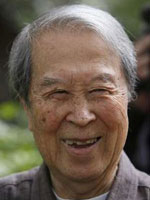Three Japanese won the Nobel Prize in physics

Professor Yoichiro Nambu, one of the three Nobel Prize winners in physics.Photo: Reuters.
Three scientists were awarded for their merit in explaining the behavior of subatomic particles, an important finding for modern physics.
Yoichiro Nambu, emeritus professor at the University of Chicago (USA), received half of the bonuses for discovering spontaneous symmetry breaking mechanism in subatomic particles - the work he had done nearly half century. His findings help scientists explain why the universe is made up of matter particles, not antimatter particles.
"I once intended to give up," the 87-year-old professor said when he heard he had received the prize.
Yoichiro Nambu was born in Japan but has lived in the United States since 1952. He officially became a US citizen since 1970 and taught at the University of Chicago for 40 years. He published the theory of spontaneous symmetry breaking mechanism of subatomic particles in 1960. The committee awarded the Nobel Prize to confirm the theory of Yoichiro Nambu to help people better understand the operation of the universe.
To explain the mechanism of spontaneous symmetry breaking, Yoichiro Nambu considers each material particle a guest at the party. Symmetry is maintained when guests use the right plate of food. It was broken when a visitor took the wrong disk, forcing the rest to do the same to avoid the situation that one person uses two disks.

Makoto Kobayashi at a press conference in Tokyo on October 7, 2008.
Two Japanese scientists, Makoto Kobayashi and Toshihide Maskawa, shared half of the remaining amount by discovering the source of the spontaneous symmetry breaking mechanism.
Makoto Kobayashi, born in 1944, works for the High Energy Acceleration Research Organization (KEK) in Tsukuba. Toshihide Maskawa, born in 1940, is a professor at Yukawa Institute of Theoretical Physics at Kyoto University.
In 1972, Kobayashi and Maskawa found the cause of subatomic particles not following the symmetric rules. Thanks to this discovery, the two men correctly predicted the existence of a new group of quarks (a type of subatomic particles). Nearly 30 years later, their predictions were proven true.
 Toshihide Maskawa, emeritus professor of Kyoto University, at a press conference on October 7, 2008 in Kyoto. Photo: Reuters.
Toshihide Maskawa, emeritus professor of Kyoto University, at a press conference on October 7, 2008 in Kyoto. Photo: Reuters.
"The research of the three scientists helps us understand what happens inside the smallest structures of matter," the Swedish Royal Academy of Sciences, which awarded the Nobel Prize in physics, said.
Speaking at a press conference on October 7, Toshihide Maskawa said he never thought he would get a Nobel Prize.
"I do science not because of awards. I just pursue my passion," he said.
Makoto Kobayashi said: "As a scientist, I am not too happy. The Nobel Prize has no special meaning for me."
Nobel Prize in chemistry, literature and peace will be announced this week. The Nobel Prize ceremony will take place on October 13.
- Why are Nobel Prize recipients getting older?
- Japanese scientist won the 2014 Nobel Prize in Physics
- Nobel history and things to know
- Gravitational wave discovery work won the 2017 Nobel Prize in Physics
- The 2015 Nobel Prize for physics was awarded to research subatomic particles
- The Nobel Prize is not in the Nobel's 'vision'
- Three light experts won the Nobel Prize in Physics
- The invention of laser won the Nobel Prize in Physics 2018
- Inventing CCD won the 2009 Nobel Prize in Physics
- Japanese-English writer Kazuo Ishiguro won the 2017 Nobel Prize for Literature
- The only scientist twice won the Nobel Prize in Physics
- Ig Nobel 2013: Applause is breaking the law to win peace
 Vietnam 5th Asian champion on fuel-efficient vehicles
Vietnam 5th Asian champion on fuel-efficient vehicles We can read all NASA studies completely free of charge
We can read all NASA studies completely free of charge Singer and songwriter Bob Dylan won the 2016 Nobel Prize for Literature
Singer and songwriter Bob Dylan won the 2016 Nobel Prize for Literature Scientific revolution in Asia
Scientific revolution in Asia